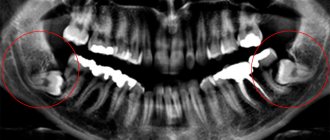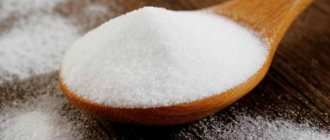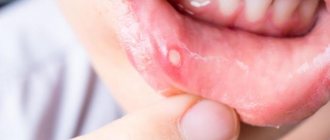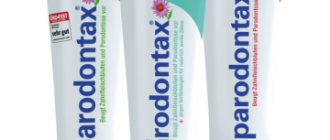Composition and beneficial properties
Baking soda is sodium bicarbonate NaHCO3, which is a white powder with small crystals. Sodium bicarbonate is easily soluble in water, due to which it can be used without problems as a means for preparing various solutions for rinsing purposes. This solution has an antiseptic effect, so it can be used to alleviate the patient’s condition with gum inflammation.
This type of packaging can be found in every kitchen!
The reaction of soda with acids formed in the oral cavity and negatively affecting tooth enamel leads to the formation of carbon dioxide and water, which means additional protection of the enamel from destruction. A solution of sodium bicarbonate is also useful for thrush localized in the mouth, since soda creates an alkaline environment in the mouth that is detrimental to the fungus that causes the disease.
Application with peroxide
Home treatment of periodontal disease with soda and peroxide can quickly relieve inflammation, kill pathogenic bacteria, normalize blood flow to the gums and significantly increase oxygen supply to cells.
To treat inflamed gums, you can prepare a paste, for this take:
- 3 g sodium bicarbonate powder;
- 10 drops of lemon juice;
- 20 drops of 3% peroxide solution.
Mix food powder with lemon juice and then add hydrogen peroxide. Use the mixture for regular brushing of your teeth and leave the paste in your mouth for 10-15 minutes, then rinse your mouth thoroughly. After 7 days you will feel significant improvements, after 14 days from the start of the procedure, take a 5-day break and repeat the procedure again.
You can use peroxide in tablets; for this you need to dissolve 2 tablets in 100 ml of water and rinse until the signs of the inflammatory process completely disappear. If this disease is advanced, then 15 drops of a 3% peroxide solution and half a teaspoon of sodium bicarbonate must be dissolved in 25 ml of water. Then use a sterile gauze pad to massage the inflamed gums twice a day. The total course of therapy should not exceed 1 month. You can also use peroxide yourself; to do this, moisten a gauze pad (sterile) with the solution and wipe the sore gums on both sides. Such procedures will help strengthen the gums and prevent their bleeding.
Methods of using soda to treat stomatitis, gumboil, etc.
For various oral problems, soda can be used either in its pure form or in combination with auxiliary ingredients. Most of these recipes are easy to prepare and can be used at home.
In its purest form
Soda solution is primarily recommended as a pre-medical measure for toothache. To prepare the solution you will need 200 grams of warm boiled water, in which 1 tsp should be dissolved. sodium bicarbonate. Make sure that the soda is stirred until completely dissolved - only then can you begin the rinsing procedure, which must comply with the following rules:
- Rinsing is carried out after meals, as well as directly at night.
- It is necessary to rinse your mouth with a soda solution, slightly tilting your head back. Rinse the area where the pain is located especially carefully.
- After rinsing, spit out the liquid and repeat the action 2-5 more times. This will help relieve pain for a couple of hours, but it is better to make an appointment with your dentist as soon as possible to eliminate the cause of this pain.
Even without additional components, soda is an effective assistant.
The same rinsing solution is also relevant for gum inflammation caused by various factors. The method of application is identical to the use of soda solution for toothache, but you will need to rinse every two hours. The inflammatory process is reduced due to the softening of gum tissue, and soda can significantly reduce tissue irritation after the first use.
Stomatitis is another oral disease against which rinsing with soda is effective. The solution can be weakly concentrated (a teaspoon of the product per glass of warm boiled water) or have a high concentration (two teaspoons per glass of water). To quickly get rid of the manifestations of stomatitis, you need to rinse your mouth as often as possible, every 2-3 hours. After rinsing, you should not drink or eat for about half an hour - this is necessary so that the soda continues to have a healing effect.
With flux, rinsing with soda can relieve swelling, relieve pain and eliminate inflammation. Dissolve a teaspoon of powder in a glass of warm boiled water and rinse your mouth every two hours until acute symptoms are eliminated. In the future, you can rinse your mouth 4 times a day after meals until the flux goes away.
Rinsing with a soda solution prepared according to the same principle is relevant as a means of preventing caries, since soda not only cleanses the mouth of food debris, but also creates an environment unsuitable for the growth of bacteria. For such prevention to be as effective as possible, each rinse should last at least 30 seconds. If caries has already affected the teeth, rinsing will only eliminate the pain, and for final treatment you will need to visit the dentist's office.
With auxiliary ingredients: salt, lemon, hydrogen peroxide
Often, to enhance the beneficial properties of soda, traditional medicine recommends adding other ingredients to medicinal formulations. The most popular combination is a soda-salt solution, to create which you will need to mix 1/2 teaspoon of sodium bicarbonate and the same amount of table salt in a glass of warm boiled water. Sometimes a couple of drops of iodine are added to this composition. This remedy is recommended for patients with inflammation in the oral cavity, gumboil, acute toothache, and bleeding gums. Rinsing with the solution will also help those who want to whiten their teeth and prevent caries and infections. In each case, it is necessary to continue rinsing until the desired result is achieved.
Baking soda and lemon are often used to whiten teeth
Combinations of baking soda and other ingredients are often found in the arsenal of those who strive for a snow-white smile. Here are the main compounds that help make your teeth a couple of shades lighter.
- Baking soda + hydrogen peroxide 3%. Mix a small amount of baking soda with 2-3 drops of peroxide until the ingredients form a homogeneous mixture. Apply the resulting paste to the brush and brush your teeth evenly for 3-4 minutes. After the whitening procedure is completed, rinse your mouth thoroughly with water. It is not recommended to use every day.
- Soda + lemon juice. Dip a damp toothbrush into the baking soda until some of the product remains on the brush. Add a few drops of lemon juice on top and brush your teeth as you would with regular toothpaste. This remedy is only suitable for healthy teeth, as it is quite aggressive on the enamel, so it is better to use it rarely - for example, before some important event.
- Soda + strawberries. Take a few ripe berries, mash them to a pulp and mix with soda in equal quantities. Apply to a soft-bristled brush and brush your teeth, then leave the composition in the mouth for another five minutes for a better effect, then rinse your mouth with clean water and brush your teeth again with a paste that should contain fluoride. The product can be used no more than once a week.
- Baking soda + hydrogen peroxide + lemon. Add the same amount of lemon juice to 1/2 teaspoon of baking soda and pour 5 drops of 3% hydrogen peroxide into the resulting mixture. Once you have a homogeneous mass, apply it to your teeth so as not to touch your gums. Leave the whitening solution on for 3-4 minutes, then rinse your mouth with warm water. It is not recommended to apply intense temperature to the teeth for several hours after such a procedure - it increases the sensitivity of the enamel, so that too hot or cold foods and drinks can cause discomfort and toothache.
- Soda + egg white. Separate the white from the yolk and mix it with soda, taken in the amount of one tablespoon. Use the resulting paste to brush your teeth for 5 minutes, then rinse your mouth with clean warm water. This paste can be used every day until the desired result is achieved, after which it can be used occasionally to maintain it.
Features of rinsing for children
Soda is a fairly harmless substance that can be used to improve the health of the oral cavity not only in adults, but also in children. It can bring the first benefit already at the time when the child’s teeth are just beginning to emerge; as a rule, this is accompanied by swollen gums and painful sensations, which is why the child is capricious and restless. In order to eliminate these symptoms, it is necessary to prepare a soda solution (a teaspoon of the product in a glass of warm boiled water) and treat the child’s oral cavity with a gauze swab dipped in this solution.
When teething, baking soda will help the baby
The immune system of an infant is not yet fully formed, and this can often cause the development of oral thrush. A solution of soda (1 teaspoon of soda per glass of water) will also help in this case: if you wash your baby’s mouth with this solution several times a day, the thrush will go away fairly quickly. However, to consolidate the result after the symptoms disappear completely, you will need to use the solution for a couple more days. To prevent thrush from returning, it is recommended to treat objects with which the child often comes into contact with a soda solution - toys, rattles, teethers.
For other oral diseases in children, soda is used in the same way as in adults. However, a method such as rinsing may not be available due to the child’s young age, in which case parents should choose another method of delivering the solution to the affected area - for example, using a gauze swab. Before this procedure, parents need to thoroughly wash their hands (ideally use rubber gloves).
How to treat periodontal disease with soda
We all know that sodium bicarbonate contains a large number of useful substances that can fight various ailments and successfully eliminate them; gum inflammation is no exception. Sodium bicarbonate is used for medicinal purposes:
- as a solution for daily mouth rinse;
- thick mixture for massaging the gums;
- can be added to toothpaste;
- take orally only after consulting a doctor.
There is a simple Sami recipe that many people know - a solution of water and bicarbonate powder. To prepare the solution, it is recommended to take water at a temperature of about 40 degrees. And then fill a glass with water, take a heaping teaspoon of sodium bicarbonate powder, and dissolve. After the powder has completely dissolved, you can use the solution to rinse the mouth.
This solution is excellent for both treatment and prevention of various inflammatory processes.
Treatment of periodontal disease at home with soda will help you quickly eliminate the main symptoms of inflammation and return to normal life. Try preparing the solution according to this recipe: stir 1 tsp. salt, the same amount of bicarbonate and 2 tbsp. l. birch ash. Add 300 ml water and mix well. Brush your teeth with this solution for 8 days. Your teeth will not become loose, stones will disappear, and your gums will become much stronger.
There is also a good and simple recipe in which 1 tsp. Soda powder is mixed in 300 ml of water and the solution is ready for use. Using a bandage wrapped around your index finger, wipe your gums and teeth morning and evening to improve oral health.
Contraindications
First of all, it is important to take into account that the whitening effect of soda is a consequence of its abrasive effect on the enamel surface, so you should not overuse such cleanings, because this can destroy your teeth. Brush about once a week, and in between brushings, use toothpaste with a high fluoride content - this will help quickly return the enamel to its original condition.
If we are talking about formulations containing both soda and hydrogen peroxide, they cannot be used in the following cases:
- High sensitivity of teeth
- Caries
- Pulpitis
- Gum health problems (periodontal disease, bleeding)
- Naturally thin tooth enamel
- Inflammatory process in the oral cavity
Also, such compositions can cause disturbances in taste perception.
Dentists categorically do not recommend using soda and compounds with it if you wear braces. During this period, any lightening procedures are contraindicated, including traditional medicine methods, as this can lead to the formation of persistent dark spots on the teeth.
Bleeding gums
Hepatitis
6417 09 March
IMPORTANT!
The information in this section cannot be used for self-diagnosis and self-treatment.
In case of pain or other exacerbation of the disease, diagnostic tests should be prescribed only by the attending physician. To make a diagnosis and properly prescribe treatment, you should contact your doctor. Bleeding gums: causes of occurrence, what diseases it occurs with, diagnosis and treatment methods.
Definition _
Bleeding gums occur when brushing teeth or chewing hard foods, such as apples or raw carrots. It should be remembered that in some cases this condition may be a symptom of serious oral diseases such as gingivitis and periodontitis.
In addition, a large amount of data has now been accumulated proving the relationship between diabetes mellitus and cardiovascular pathologies with inflammation of the periodontium (tissues surrounding the teeth).
Types of bleeding gums
According to the frequency of manifestations, bleeding gums can be chronic, that is, occurring regularly, or be situational in nature - usually in response to gum injury.
Possible causes of bleeding gums
The causes of bleeding gums can be divided into two main groups:
- Pathologies of the oral cavity.
- Pathologies of body systems.
Pathologies of the oral cavity
- Gingivitis
. This disease is characterized by the development of inflammation of the mucous membrane of the gums. Symptoms of this condition include redness or bluishness of the gums, swelling and bleeding. In advanced cases, manifestations of the disease interfere with eating and disturb even during sleep.
- Periodontitis
is a disease that requires a visit to the dentist. It is characterized by severe bleeding gums, loose teeth, the necks of which are exposed, resulting in teeth falling out. Periodontitis is often accompanied by severe inflammation, up to the discharge of pus from the pocket that forms between the tooth and the gum.
- Tartar
is hardened food debris and waste products of oral bacteria. It injures the gums, which leads to their bleeding. There are subgingival stones (outwardly invisible) and supragingival stones (visible to the naked eye).
In addition to bleeding, all gum diseases are characterized by the following symptoms:
- unpleasant and painful sensations when touched (pressing on the gums, brushing teeth);
- bad breath;
- increased salivation not associated with other diseases of the oral cavity or gastrointestinal tract;
- dental plaque and calculus;
- change in the appearance of the gums (swelling, redness or cyanosis);
- change in the appearance of the teeth (exposure of the neck, change in color due to the deposition of tartar).
Another, albeit rare, cause of bleeding gums is the increased content of fluoride in drinking water.
After water analysis has confirmed the high content of this element, it is recommended to use various filters to purify running and drinking water. The most common pathologies of the body leading to bleeding gums
are vitamin deficiency
. The well-known disease scurvy is associated with insufficient intake of vitamin C in the body, this is manifested by increased bleeding of the gums, impaired collagen synthesis, as a result of which the connective tissue cannot fully perform its functions.
The cause of bleeding gums may be insufficient intake of vitamin A (retinol), riboflavin and pyridoxine (B2 and B6), calciferol (vitamin D, in particular, its variety - vitamin D3), tocopherol (vitamin E), nicotinic acid (vitamin PP ) and vitamin K. The latter not only affects the structure of tissues, but also participates in blood clotting processes.
Hormonal changes in the body
, which occurs during pregnancy and puberty in adolescents, may also be accompanied by bleeding gums.
For diabetes
Small vessels throughout the body are affected, including the oral cavity, retina, etc.
Hepatitis
of various etiologies is also characterized by the development of bleeding gums, since many blood clotting factors are synthesized in the liver . Taking into account the fact that the human blood coagulation system works on the principle of a cascade, a deficiency of at least one element leads to impaired hemostasis. Hepatitis is characterized by a mixed type of coagulation disorder, caused by a lack of many vitamins as a result of impaired absorption, a decrease in platelet levels, and damage to the liver as a source of coagulation factors.
Leukemia
, as well as
blood diseases of various types
, leading to a decrease in the number of platelets, or vice versa, increasing blood viscosity, can manifest as increased bleeding of the gums. With these diseases, attention is drawn to pallor of the skin and visible mucous membranes, the appearance of bleeding in various locations, bruises, increased fatigue, and weakness; Night sweats and fever not due to any other reasons are possible.
Which doctors should I contact if I have bleeding gums?
First of all, patients with bleeding gums turn to the dentist.
If the doctor cannot find the root cause of the bleeding, consultation is necessary, or.
Diagnosis and examinations for bleeding gums
If diabetes mellitus is suspected as the cause of bleeding gums, it is necessary to prescribe a glucose tolerance test, determination of glycated hemoglobin in the blood, determination of blood glucose levels on an empty stomach and during the day.










